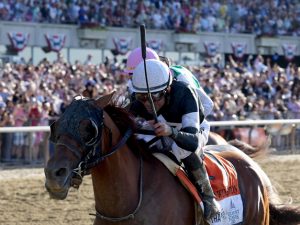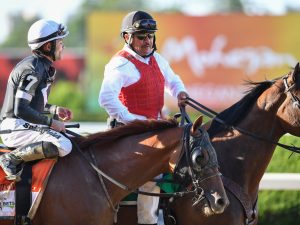
Sir Winston – Photo Courtesy of NYRA
Who says horses aren’t sensitive? Who says that they don’t know what’s going on? If you have any doubts as to the equine’s awareness, it might be time to have a conversation with Sir Winston, the 2019 Belmont Stakes Champion.
All week long, Sir Winston hung out in his stall, a few doors down from the 2019 Preakness Stakes Champion, War of Will. All week, reporters assembled at that barn, asking trainer Mark Casse and his staff if that colt could take the Preakness and thus, two-thirds of the Triple Crown. And if so, the questions would begin—had Maximum Security not impeded War of Will, would we be looking at a second consecutive Triple Crown winner?
If you don’t think Sir Winston wasn’t listening to all this banter, then you don’t know horses. Every time reporters descended upon Will’s stall, Sir Winston stuck his head out and wondered why he wasn’t getting any attention. While his stablemate garnered the accolades—deservedly so—there was Sir Winston planning his tactics for the big, bad Test of the Champion Belmont Stakes in a few days.
In that race, Sir Winston executed beautifully. What was impressive is that he didn’t let all that lack of attention fire him up negatively. Let’s face it, the colt felt slighted; he wondered why nobody gave him any love? Because of that, one would think the colt would come out flying and burn out.
That didn’t happen and if you have doubts, all you had to do was listen to the jockey, Joel Rosario. Rosario decided to let the colt do his thing and that’s what he did. He rated and stalked for six furlongs, then with half the race to go, began to make his move. The Belmont is known for being a jockey’s race and Rosario proved that by moving deftly to his right then back in for the run down the stretch. In deep stretch, it was over. Sir Winston, the second stinger in Casse’s barn had triumphed. His final time was a respectable 2:28.30 over the fast Big Sandy surface.
Sir Winston didn’t come into the race with tremendous accolades. He had just two wins in nine starts, but pedigree was on his side. His father is Awesome Again, a Canadian bred who won the Queen’s Plate and then ended his career when he won the Breeder’s Cup Classic as a 4-year old, while his grandfather via his mother was none other than Afleet Alex, the 2005 Preakness and Belmont Stakes Champion.
After the race, a supremely proud Sir Winston stood for a quick interview.
“I think the other horses took me lightly,” the colt said. “All the attention was given to War of Will for the Preakness and Tacitus, the hometown kid for winning the Wood Memorial. Everybody kind of forgot about me.”
“I was ready to go, I wanted to prove to all that I am a legitimate horse, a horse that’s going to be a force this summer and fall. I’m still finding my stride. The mile-and-a half was easy for me, but I think I might be even better at 1 ¼ miles.”

Sir Winston
Sir Winston and Rosario shared some synergy as well. Every time Rosario wanted something, Sir Winston gave it to him. The replays show the two completely in tune with one another for the entire 1.5 mile race. That’s what makes the Belmont the toughest of the three races to win. If the colt can’t relax, rate and stalk, they won’t win. Master Fencer waited too long to make his run, for the Belmont is not for closers. If you can’t rate and stalk, you really can’t win it because those 12 furlongs are the truest of grinds.
“I told Joel to sit back and enjoy the ride, I’ll let you know when I’m feeling good,” the colt said.
Rosario tapped him with the whip five times to make sure that once he got the lead, he kept focus and his eyes on the prize.
“I probably didn’t need the whip,” the colt said, “but I didn’t mind it all. It’s a long race and my man (Rosario) was trying to get me through. He’s (Rosario) a nice kid.”
In the 2008 Belmont, Da Tara pulled off the upset when he denied Big Brown the Triple Crown. That colt didn’t do much after his big classic win, so we’ll have to wait to see what becomes of Sir Winston going forward.
You never know with horses, but in this case, we got a horse that came to the Belmont with a bit of a chip on his shoulder who delivered the goods in a big way.

As a kid growing up in the Buffalo suburbs in the 1970s and 80s, the radio was one of John Furgele’s best friends. In the evenings, he used to listen to a show on WBEN radio called “Free Form Sports,” hosted by Buffalo broadcast legend Stan Barron. The show ran weeknights from 6 to 11 pm and featured every kind of sport you could imagine. One minute, Mr. Barron was interviewing a Buffalo Sabres player; the next, he was giving high school field hockey scores.
But there was always one thing that caught John’s ear. During those five hours, Barron would give the results from Western New York’s two harness racing tracks — Buffalo Raceway and Batavia Downs. This is where John learned what exactas, quinellas, trifectas and daily doubles were all about. From then on, he always paid attention to harness racing, and when Niatross (a legendary Western New York horse) hit the scene in 1979, his interest began to blossom.
John believes harness racing is a sport that has the potential to grow and he will explore ways to get that done via marketing, promotion and, above all, the races themselves.
When he’s not watching races, John is busy with his family and his job in sales. Like the pacers and trotters, he does a little running himself and you’ll occasionally find him “going to post” in a local 5K race.


